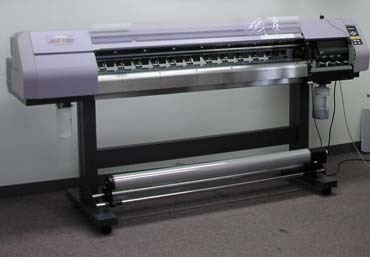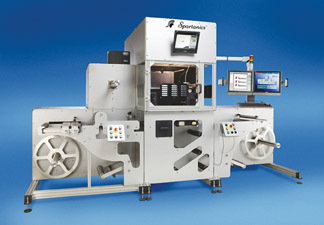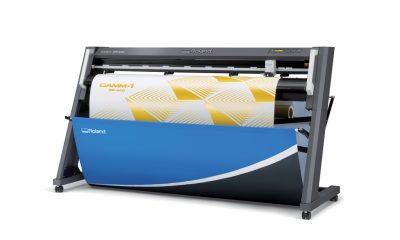Graphics Printing
Published
18 years agoon

Advanced Digital and Screen Printing is a graphics-printing shop that combines ambition, a desire to succeed, willingness to adopt new technologies, and strong family ties to thrive in a fiercely competitive and ever-changing marketplace. Discover how Advanced grew from a small operation with a single client to a bustling business with capabilities that satisfy a variety of retail graphics buyers.
Family roots
Advanced Digital and Screen Printing is a graphics-printing shop that combines ambition, a desire to succeed, willingness to adopt new technologies, and strong family ties to thrive in a fiercely competitive and ever-changing marketplace. Discover how Advanced grew from a small operation with a single client to a bustling business with capabilities that satisfy a variety of retail graphics buyers.
Family roots
Dave Ramsey founded Advanced Digital and Screen Printing in Columbus, OH on January 1, 1985. He had no formal training or experience in screen-printing technology, but had acquired a variety of skills through his experiences in other industries. Ramsey graduated from Ohio State University with a degree in engineering. There, he was introduced to the industry that he would eventually join when a class assignment required him to design a plant lay-out for a screen-printing shop.
Ramsey accepted a position with Varsity House, a textile-printing shop, after graduating from college. He worked in production, planning, and warehousing for five years. In 1976, Ramsey accepted a management position with Electrographics, a printing company that specialized in posters and decals. After nearly a decade there, he left the screen-printing industry for another field, but was ultimately dissatisfied with his choice. Ramsey discussed the direction of his career with two former clients, one of whom remarked, "Columbus is yours if you just open a business!" That was the encouragement Ramsey needed to strike out on his own and return to screen printing.
Ramsey, with the support of his wife, Linda, started his printing business with a single Filbar press to print P-O-P displays. He relied on word-of-mouth referrals to develop the shop’s client list. In fact, Ramsey met one of his major customers while attending his son’s soccer game. An informal introduction and chat about his printing business secured Ramsey an order for seven print jobs. Revenues from that client alone paid for four years of rent for the facility and covered the salaries for the small shop’s staff.
Advanced added several pieces of equipment during the following decade to support the business’s growth: vinyl plotters from Gerber and Allen Datagraph, an M&M graphics press, another Filbar graphics press, and two Cincinnati one-arm presses. Ramsey expanded his staff in 1995. He hired Susie Basso as art director and appointed Brian Nordmoe to serve as the company’s president and general manager. Nordmoe was engaged to Ramsey’s daughter, and the personal connection created some initial concern for both men. However, Nordmoe was quick to seize the opportunity, especially since he was ready to hang up the suits and ties he previously wore in the corporate world.
Advanced’s growth, while welcomed, also challenged the shop. The company occupied seven spots in a ten-unit facility, and the building’s odd layout eventually burdened the production workflow. Doors connected the seven rooms, and each room housed a different piece of equipment. The employees had to carry substrates, by hand, through several sets of doors during production. Carrying substrates that wouldn’t fit through the doors meant taking the materials outside and into the next room. To make matters worse, the facility lacked a forklift and loading bay, so the staff had to unload shipments from the delivery trucks by hand.
Ramsey soon realized that relocating to a larger facility—one that would support a layout more conducive to the screen-printing workflow—would make it easier for Advanced to continue growing the number of orders, personnel, and pieces of equipment in the shop. He then met with his insurance agent, who was also a trusted friend, and began discussions about purchasing a five-acre lot not far from the company’s original location. Ramsey initially had reservations about such a purchase, but his friend’s ideas about Advanced’s success inspired Ramsey to take the leap. He purchased that five-acre lot and moved Advanced to it in 1996. Three buildings stand on the parcel, one of which Advanced calls home.
"Small companies need good ad-visors around them—the right people to see the vision and future of the company," Ramsey says. His advisors certainly realized early on the benefits Advanced would gain from its land purchase. The acquisition allowed for more than just expansion on the property: A nearby landfill is undergoing conversion into a golf course, presenting Advanced with the potential for a significant increase in real-estate value.
The new facility’s bigger space allowed Advanced to add equipment that would help it grow. The company added an electric dryer line, and over the next few years, brought in two Parapress graphics presses, a Tektronix Phaser printer, a Douthitt exposure unit, an M&R Eclipse press, and an HP 1050 digital printer.
Advanced made a major change in its printing processes in 2000 with the switch from solvent to UV inks, which necessitated the purchase of a UV dryer line. Later, the company added an American M&M Daytona press, an HP 5000 inkjet printer, a 60-in. Seal Laminator, and a Mimaki JV inkjet printer. Other equipment purchases included an Eclipse press, another UV dryer line, an Encad Novajet Pro 750 inkjet printer, and an M&R Renegade XL graphics press.
In 2002, Ramsey expanded his team of employees with a salesman. He also recognized the skills that his own children could bring to the business, and in 2003 hired his son Chad to handle information technology. Ramsey also hired his daughter Alyson the next year to serve as the office manager.
Ramsey admits that bringing family members into the business can create friction now and then. Ramsey and his children—and their spouses who work at Advanced—are a tight-knit group inside and outside the office, which means they must take extra care to respect each other’s opinions and decisions. They also make a concerted effort not to discuss business while at family gatherings, which may take place two or three times each week. Ramsey says keeping these family relationships solid is important to him, especially because one of his goals for the business is a successful transition of ownership and management from the first generation of the family to the second and beyond.
Inside Advanced
It all begins in the prepress department, where Susie Basso does her magic designing and preparing image files. Several pieces of the company’s equipment call the art department home, including the Mimaki JV4-130 plotter and HP 5000 proofing device. Basso uses the Mimaki printer (Figure 1) to produce film positives and the HP 5000 to generate proofs for use in house and as a backup for the company’s flatbed inkjet printer. She uses Adobe Creative Suite programs to prepare artwork.
The screen room is where you’ll find the company’s Douthitt DMV 79 x 190-in. exposure unit. Here, Geoff Bommer coats all screens for both process and spot-color jobs by hand (Figure 2). He typically applies five coats on one side of a screen, flips it over and applies one coat, and then applies one face coat on the other side of the screen. He regularly measures the tension of screens stocked in the room, labels each screen with pertinent information such as size, tension, and date the screen was stretched, and he keeps the details in a log.
In the production area are four M&R semi-automatic graphics presses, including two Eclipse models (36 x 24 and 40 x 50 in.), a 40 x 55-in. M&R Renegade press, and a 48 x 120-in. Renegade XL press (Figure 3). The XL model, purchased in March of this year, is the newest addition to the graphics-printing equipment. The company’s original Filbar press, along with an M&R Vitran II, and a Daytona press round out the equipment in the graphics-production area.
The finishing department, which is located next to the production area, is equipped with a Seal Image 600 (60 in.) laminator. It’s also where Ron Cooper uses his numerous years of experience in classic screen-printing methods and sign lettering to put the final touches on print jobs. Ron sometimes traps films by hand when the high-tech software programs in prepress can’t handle the job.
The digital side
Advanced used to outsource orders for digital jobs to Columbus, OH-based Key Color. In 2002, Ramsey asked one of Key Color’s employees to join Advanced Digital and Screen as the sales representative for digital printing services. As luck would have it, Advanced’s newest employee brought along digital print jobs and a lot of orders for screen printing.
Advanced purchased a MacDermid ColorSpan 72UVR inkjet printer in 2005 to bolster its efforts in digital imaging (Figure 4). The company has found it ideal for producing one-off jobs. Ramsey was initially concerned about the speed and expense of a digital printer, but he quickly overcame his doubts when he noticed the increased use of digital printers in producing P-O-P signage for retail businesses throughout Columbus.
"P-O-P signs used to be spot-color work, but they had no pizzazz. Now P-O-P is a four-color process with high resolution and a high impact level," Ramsey says. "We needed to adopt the technologies and processes to achieve that look. We realized early on that we had to get into digital. It is a perfect complement to screen printing."
Progressive technologies
Advanced recently implemented the Chromatix program to meet customer demand for high-quality color reproduction and consistency. The program was developed by ReyHan PGF, which recently became Nazdar Consulting Services. Developers of the program describe Chromatix as an organized, methodical, field-tested, and verified system designed to eliminate weaknesses in color reproduction, capitalize on strengths, and deliver consistent results.
The decision to pursue Chromatix certification came after Mark Umensetter, Advanced Digital and Screen’s production manager, and Chad Ramsey, who manages quality control, color, and digital printing, attended a four-color-process-printing workshop conducted by the Specialty Graphic Imaging Association.
The process began with profiling Advanced’s HP 5000 inkjet printer, developing film-positive curves in the art department for each major substrate that Advanced uses, and documenting everything. Advanced’s staff was hesitant at first about changing procedures and trusting numbers instead of eyes. The team learned new techniques in the screenmaking department and must follow standard operating procedures set in place under the Chromatix program. To ensure consistency and accuracy, each employee completes a sign-off sheet after each step in the workflow.
Nordmoe says Advanced hopes to use Chromatix to learn how to preflight all incoming files and correct them to successfully flow through the shop’s color workflow, produce in-house qualified digital proofs for internal use and external sign-off, consistently print graphics at 70-80 lines/in., match their digital proofs on all jobs, and teach all employees how to analyze and troubleshoot process-color printing—including the necessary steps to correct the problem, bring the job back into specification, and match proofs every time.
Building relationships
Advanced emphasizes building solid relationships and keeping the lines of communication open. These principles are vital in the staff’s interaction with each other and with the shop’s clients. "We like to build relationships because relationships withstand the competition," Ramsey says. "We like our clients to know us, to trust us."
Ramsey employs what he refers to as the Lazarus Return Policy, based on the well-known department store’s commitment to keeping its customers satisfied. He says Lazarus used to guarantee customer satisfaction by replacing returned items with products of a shopper’s liking. Ramsey strives to extend the same commitment and dedication to his clients.
If clients are not satisfied, Advanced is prepared and willing to do whatever it takes, even if it means redoing a job. Part of this practice includes honesty with clients about limitation, time constraints, and the occasional inability to accommodate a particular job on a tight deadline.
"We are constantly in touch with our customers," Ramsey says. "Communication is huge, and that is wrapped up in our relationship with our customers."
If a problem should occur in the 11th hour of a print job, and sometimes it does, the folks at Advanced contact their client, explain the problem, offer alternative options, and work with the client to find a solution. "Customer relationships—you can build and build and build them, but if you screw it up once, you lose the relationship and have to start over," Ramsey says.
Ramsey once read a business statistic that startled and motivated him: Ninety percent of all business fail in the first five years. Seeing that number boosted Ramsey’s determination to be among the 10% that succeeded. Many times, that meant that he’d have to work long, hard hours and many weekends to get his business off the ground and running, build his list of customers, and keep his customers happy. "I was never a printer," Ramsey says. "I was a manager. But when you start a printing business, you become a printer."
Advanced Digital and Screen Printing produces a variety of P-O-P work. Most of the job orders come from five loyal clients. One of them—a national grocery chain—has been Advanced Digital and Screen’s biggest account for years, and this client’s work occupies a majority of the shops production time. Even though Advanced’s clients keep the jobs coming in and the presses running, the company continues to work on expanding its client list. The company focuses on retail chains, including pharmacies, clothing stores, and restaurants. Ramsey says his goal is to secure up to 150 new accounts, and possibly as many as 300.
The Chromatix program will play a crucial role in the company’s plans to diversify its clientele. Ramsey explains that third parties often conduct much of the business when Advanced works with retail accounts, so the shop must be able to present consistent, repeatable results to all parties involved in winning a job order.
Preparing for transitions
One of Ramsey’s primary goals is to turn over his business to his children, who will then hand the business down to their children (Figure 5). Therefore, he must keep his family in mind when making decisions that affect the company. Training is another tool Advanced uses to make sure future generations will be able to manage operations.
Training at Advanced mostly occurs on the job through hands-on experience. Ramsey and Nordmoe make sure that employees keep current with industry knowledge by sending them to training courses offered by companies and organizations in the digital- and screen-printing industries.
Advanced also plans to diversify its product offerings, and to support this goal, the company intends to add more wide-format digital-imaging equipment. The team is currently researching and considering several options for its next purchase. On the screen-printing side, Advanced’s main goal is to complete its Chromatix program, which will enable the company to deliver more consistent color. The company also is investigating the possibility of bringing an automatic coating machine to its screenroom.
Advanced Digital and Screen has been evolving its operation to be a full-service provider of high-quality graphics for a variety of applications. By focusing on building a strong staff, versatile equipment line-up, a broad assortment of printing and finishing capabilities, and wide selection of products, Advanced is positioning itself as a one-stop shop that can handle the design, printing, packaging, shipping, and application of graphics. The company’s vision has paved the way for success that is likely to continue increasing with each new generation of the Ramseys that becomes involved in the family business.

Subscribe

Magazine
Get the most important news
and business ideas from Screenprinting Magazine.
Most Popular
-

 Case Studies2 months ago
Case Studies2 months agoHigh-Density Inks Help Specialty Printing Take Center Stage
-

 Art, Ad, or Alchemy2 months ago
Art, Ad, or Alchemy2 months agoF&I Printing Is Everywhere!
-

 Andy MacDougall2 months ago
Andy MacDougall2 months agoFunctional and Industrial Printing is EVERYWHERE!
-

 Columns3 weeks ago
Columns3 weeks ago8 Marketing Mistakes Not to Make When Promoting Your Screen Printing Services Online
-

 Editor's Note2 weeks ago
Editor's Note2 weeks agoLivin’ the High Life
-

 Marshall Atkinson2 weeks ago
Marshall Atkinson2 weeks agoHow to Create a Winning Culture in Your Screen-Printing Business
-

 Thomas Trimingham2 months ago
Thomas Trimingham2 months ago“Magic” Marketing for Screen Printing Shops
-

 News & Trends2 months ago
News & Trends2 months agoWhat Are ZALPHAS and How Can You Serve Them in Your Print Business?






